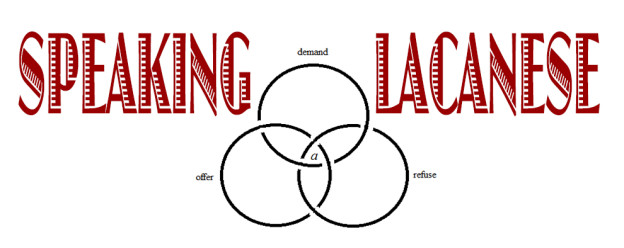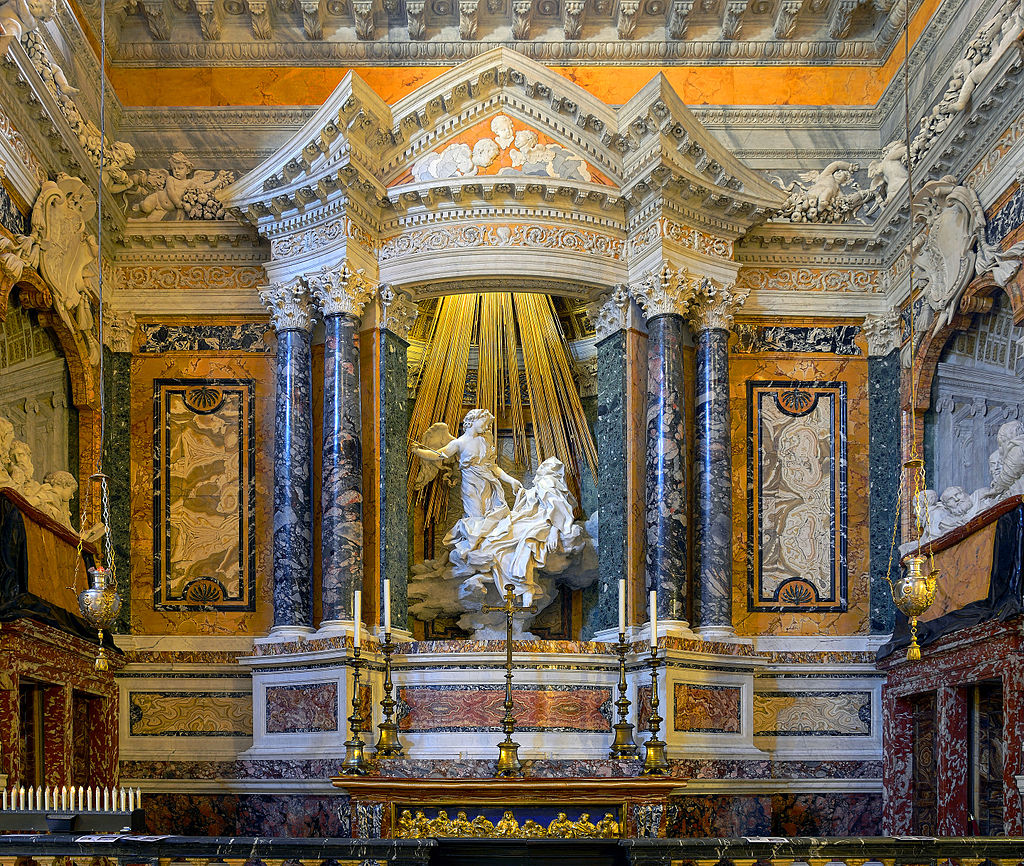REFRAMING PSYCHOANALYSIS presents the second in our series of SPEAKING LACANESE posts by Will Greenshields that seek to make legible Lacan’s various aphorisms and neologistic puns. If you disagree with the interpretation offered, have a suggestion as to how it might be improved, or would like to see a particular Lacanian phrase discussed here, please don’t hesitate to contact Will, or leave a comment below.
By Will Greenshields
Our second bit of Lacanese comes from p. 116 of Seminar XX: Encore (New York and London: Norton, 1998):
The baroque is the regulating of the soul by corporeal radioscopy.
One of the things that I most enjoy about reading Lacan is that the subject matter of his seminar sessions very often depended upon some contingent encounter (in this instance, a visit to Rome). The twenty-eight books of the Séminaire are neither the components of a philosophical Weltanschauung, nor a coherent, consistent and synthesised theoretical edifice. However, this is not to suggest that they are a scatty and ill-disciplined mess: what most often resulted from the numerous interdisciplinary confrontations between Lacan’s psychoanalytic insight and a cultural event or artefact was something precise. In his editorial preface to a series of books titled ‘Short Circuits’, Slavoj Žižek outlines the precepts of a mode of reading that is both anarchic and focused:
A short circuit occurs when there is a faulty connection in the network – faulty, of course, from the standpoint of the network’s smooth functioning. Is not the shock of short-circuiting, therefore, one of the best metaphors for a critical reading? Is not one of the most effective critical procedures to cross wires that do not usually touch: to take a major classic (text, author, notion) and read it in a short-circuiting way, through the lens of a ‘minor’ author, text, or conceptual apparatus (‘minor’ should be understood here in Deleuze’s sense: not ‘of lesser quality,’ but marginalized, disavowed by the hegemonic ideology, or dealing with a ‘lower,’ less dignified topic)? If the minor reference is well chosen, such a procedure can lead to insights which completely shatter and undermine our common perceptions. This is… what Freud and Nietzsche did with morality (short-circuiting the highest ethical notions through the lens of the unconscious libidinal economy). What such a reading achieves is not a simple ‘desublimation,’ a reduction of the higher intellectual content to its lower economic or libidinal cause; the aim of such an approach is, rather, the inherent decentring of the interpreted text, which brings to light its ‘unthought,’ its disavowed presuppositions and consequences.
In Lacan’s aphorism it is pretty clear between which crossed wires a short circuit is taking place: corporeality and the soul. As for the reading that spawned this aphorism, Lacan appears to have repeated the Freudian procedure: namely, ‘short-circuiting the highest ethical notions’ – the religious ecstasy, stimulated by God’s grace, that is exhibited by baroque sculpture – ‘through the lens of the unconscious libidinal economy.’ There are moments, however, when Lacan’s reading does not quite conform to what Žižek wants to call ‘simple “desublimation”’. Having just returned from his sojourn around Rome’s collection of contorted marble bodies, Lacan bluntly told his audience that he had the impression of being confronted with an ‘orgy’ (SXX: 113). However, as we shall see from Lacan’s more considered observations, this is a very peculiar orgy, an orgy in which the sexual rapport is absent.
Before we concentrate on the aphorism itself, it’s worth briefly taking a look at some of Lacan’s other comments on the baroque. Whilst there is certainly a place for the transcendent and immaterial in Christian doctrine (e.g. the Holy Ghost or souls), it is also the case that it chiefly concerns ‘the incarnation of God in a body’: ‘Christ… is valued for his body, and his body is the means by which communion in his presence is incorporation – oral drive – with which Christ’s wife, the Church as it is called, contents itself very well, having nothing to expect from copulation.’ (Ibid: 113) Hence the cheap wine and tasteless wafers. In this regard, the Church’s conservative parish and celibate priests are more enlightened than those of us who do have something to expect from copulation and, to reverse one of Lacan’s most famous pronouncements, do believe that the sexual rapport – the faultless (comm)union of desirous subjects – exists.
That belief in the sexual rapport is a belief that the very same lack that has been caused by language (i.e. the impossibility of ontological unity for a subject that speaks, and is spoken of, with differential signifiers that interminably displace meaning) can be made good by language (i.e. the immaculate vocalisation of one’s own desire and the perfect comprehension of the Other’s desire). There is, in Lacan’s appraisal, a certain admiration for what we might call the Catholic Church’s polymorphous perversity, its renunciation of normative, genital sexuality in favour of the ‘oral drive’. It is through the consumption of a partial object that ‘Christ’s wife’ supports a perverse rapport and derives jouissance.
It is precisely this jouissance without copulation that Lacan witnesses in the baroque ‘orgy’:
In everything that followed from the effects of Christianity, particularly in art – and it’s in this respect that I coincide with the ‘baroquism’ with which I accept to be clothed – everything is exhibition of the body evoking jouissance… but without copulation. If copulation isn’t present, it’s no accident. It’s just as much out of place there as it is in human reality, to which it nevertheless provides sustenance with the fantasies by which reality is constituted…
[As an aside, it’s worth noting that Lacan is not contending that nobody copulates, just as when he says ‘il n’y a pas de rapport sexuel’ he is not contending that nobody has sexual relations: ‘copulation’ or the ‘rapport sexuel’ are simply bywords for a normative ideal – a perfect union of partners that negates lack and results in an ontological One – that cannot exist.]
…Nowhere, in any cultural milieu, has this exclusion been admitted to more nakedly… I will go so far as to tell you that nowhere more blatantly than in Christianity does the work of art as such show itself as what it has always been in all places – obscenity. (Ibid: 113)
This last observation is not that of a miffed Protestant, made rancorous by Roman excess: art, according to Lacan, is obscene because it offers both the artist and the viewer a jouissance that is, to cite one of his puns, ‘a-normal’ – a jouissance derived not from copulation but from an object (a) that covers an irreducible void at the heart of being. If bored by his priest’s monotone incantations, the church-goer can indulge his scopic drive, gazing at this exhibition of bodily jouissance as he picks the last bits of wafer (qua oral object) from his teeth. What is particularly obscene about baroque art is that it not only provides the viewer with a jouissance not derived from copulation but that this jouissance is so obviously its subject (‘everything is exhibition of the body evoking jouissance… but without copulation.’).
Lacan’s primary reference here is Gian Lorenzo Bernini’s The Ecstasy of St Teresa (1645-52). The artist’s tableau is very much an exhibition: Bernini’s clients, the Cornaro family, look on, as if occupying boxes in a theatre, while the Spanish nun experiences the rapturous jouissance – an affect somewhere between pleasure and pain – that she had described in her book of heavenly visions and visitations.
Here, most vividly, ‘[t]he dit-mension’ – the dimension of what is said (dit) – ‘of obscenity is that by which Christianity revives the religion of men’, converting subjects not through coercion and dry scripture but through an overwhelming spectacle of divine jouissance (Ibid: 113).
Whilst Lacan’s aphorism (‘The baroque is the regulating of the soul by corporeal radioscopy’) is hopefully starting to make a little more sense, we ought still ask what exactly he means by ‘the soul’. For Lacan, Aristotle’s decision in De Anima to align the activity of thinking with the soul (as separate from the body) was problematic because ‘Man does not think with his soul… He thinks as a consequence of the fact that a structure, that of language[,]… carves up his body… Witness the hysteric… Thought is in disharmony with the soul’ (Lacan, Television, p. 6).
In other words, discordant unconscious thought – the Lacanian unconscious that has the ‘structure… of language’ and is comprised of signifying chains obscurely knotted to traumas that these chains cannot assimilate – emerges at the level of the body in the form of psycho-somatic symptoms from which the subject derives a mixture of pleasure and pain: a jouissance without copulation. The unified and coherent body of which the ego, following the Mirror Stage, believes itself to be master, is ‘carve[d] up’, fragmented and disharmonious. ‘[T]he soul is what one [consciously] thinks regarding the body’; it is this imagined unity that egoic subjects believe themselves to be – not a body affected by thought but a body supposed by thought – and, as such, it is always in disharmony with unconscious thought (SXX: 110).
‘Witness the hysteric’, witness Bernini’s St Teresa: the baroque’s visions of bodily jouissance (its ‘corporeal radioscopy’) literally provided novel and Church-sanctioned regulations for the soul: out with ascetic self-discipline and in with uninhibited ecstasy. In much the same way, Charcot’s demonstrations provided a shocking insight into the extent to which the harmony between body and thought can unravel. In this sense the baroque is really more of a deregulation of the soul by corporeal radioscopy. I’d also note that the translator’s decision to render the French ‘scopie’ as ‘radioscopy’ is perhaps an unnecessary complication; it’s more likely that Lacan had in mind the Greek, skopéo , simply meaning to ‘look upon’ or ‘inspect.’
Finally, I’d like to return to the highly suggestive parenthetical remark that Lacan made in the long passage quoted above: his acceptance of being clothed in ‘baroquism’. He makes this same observation in an even more explicit fashion earlier in the session: ‘I am situated essentially on the side of the baroque.’ (SXX: 106) This declaration has always puzzled me and I’ve never managed to reach an entirely satisfactory conclusion: is it an allusion to Lacan’s own Catholic upbringing, a salacious admission of his own ‘obscenity’ or a reference to Freud’s theorisation of polymorphous perversity (and the concomitant refutation of the ideal of sexual normality qua ‘copulation’) on which Lacan builds? In Sensible Ecstasy, Mysticism, Sexual Difference, and the Demands of History (2002), Amy Hollywood provides an alternative explanation:
Baroque, as a seventeenth century style of artistic expression, is an art of excess in which the materiality of the signifier and/ or of representation constantly threatens to supersede signification and mimesis. Similarly Lacan’s baroque style impedes interpretation, suggesting that what is crucial in his work is not signification but that which goes beyond. Lacan here makes clear that the ultimate goal of psychoanalysis is not scientific knowledge but the eruption of affect in and through language. (162)
Baroque art sought not to inform the subject but to move him. In a happy coincidence, Hollywood cites, as an example of Lacan’s baroque style, the very same aphorism that we examined in the previous entry: ‘I demand that you refuse what I am offering you… because: it is not that.’ Here, ‘that’ should be thought of as equivalent to ‘copulation.’ We saw how the effect of this peculiar knotting of verbs goes beyond signification by enabling the object to ‘arise.’ Interestingly, the very same evidence that critics provide in support of the claim that Lacan was a sort of cult leader (i.e. his carefully cultivated baroque style) is precisely the evidence that absolves him: after all, a cult leader would demand that you accept what he is offering because it is that.




